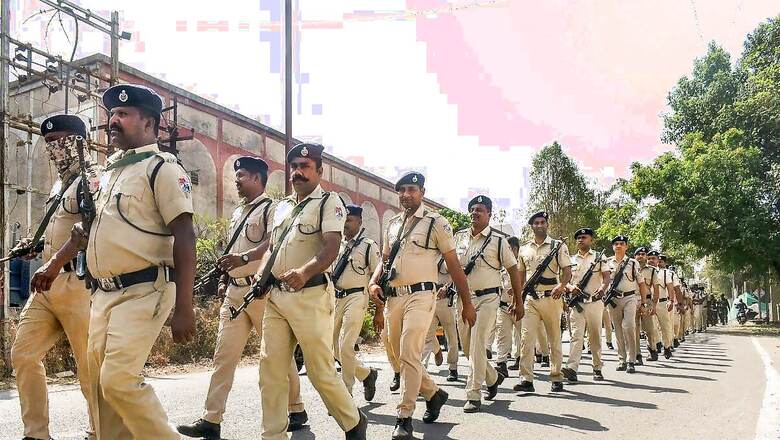
views
A recent photo of some men and women police personnel wearing dhoti-kurta and salwar-kameez within the precincts of the Ram Mandir in Ayodhya elicited indignant comments about their ‘fancy dress’. Some people evidently thought that policemen and women should only be clad in their khaki uniforms when on duty, although UP authorities clarified that the outfits were intended to make them blend in with the temple crowds to seem less obtrusive.
Both sides have a point. Law and order personnel wear uniforms not only to evoke respect and compliance from the general public but also to inculcate a sense of pride and common purpose. Being easily identifiable and therefore responsible are the major objectives of uniforms although the design and even colour vary from state to state in India. But in certain places, the presence of a lot of police personnel can create a visible and intimidating khaki wall.
That is not always a good thing though it does deter potential violators of law and order. Seeing uniformed personnel, particularly inside places of worship can seem unnecessarily menacing and unnerving. So getting law enforcers to wear dhoti-kurtas and salwar-kameez inside the Ram Mandir is a practical step to maintain security and yet not seem in-your-face to the visitors. But it is disturbing that a section of Indians apparently considers these to be ‘fancy dress’.
The implication is that such combinations are inappropriate for their jobs if not totally outlandish and comical. Yet millions of Indians still wear kurtas—with dhotis or pyjamas—every day as they go about doing their work. Why then should this attire be thought of as unsuitable whereas, say, trousers and shirts would not? This, unfortunately, betrays the lingering vestiges of a colonial mindset even as India completes its eighth decade as an independent nation.
When boys began attending Westernised schools during the British era because an English education gave them avenues for advancement, they eagerly adopted Western dress codes for uniforms too. Girls were extended that educational privilege later but their schoolwear remained indigenous, as forcing them to don skirts may have met with resistance. Eventually, though, girls wore sarees in the higher classes and skirts and blouses in the junior classes.
For most of the latter half of the 20th century, though, it was inconceivable for schools with upwardly mobile middle-class students to have ‘Indian’ uniforms. It was skirts, blouses and belts for girls, shirts, trousers (or shorts) and belts for boys; some schools also had ties and blazers. Today, even missionary schools have Indianised girls’ uniforms, with salwar-kameez-belt becoming the new trinity. But boys are still in the grip of colonial mindsets.
The same could be said of police uniforms in India. Police forces of many states have women personnel at the non-IPS levels wearing sarees as uniforms; trousers, shirts and laced boots are not mandatory. Female IPS officers, however, are mandated to wear the same Western-type uniform as their male IPS counterparts, with the option of wearing sarees only during pregnancies. Policewomen are all uniformly allowed to wear sindur, mangalsutra and bindi.
But by and large, the world has meekly–and perhaps unthinkingly—adopted the West-decreed dress code for police (with some local tweaks), almost as if law enforcement is itself a Western construct whose adoption therefore requires accepting its norms in toto, including uniforms. Both male and female police kitted out in Indian clothes, even if for duties only within the Ram Mandir is thus a bold step towards indigenisation that has no parallels worldwide.
There is no evidence to suggest that police personnel will be inconvenienced when carrying out law and order duties dressed in kurta-pyjama or salwar-kameez. Nor would these outfits hinder their ability to carry equipment, display badges of rank and identity or curtail their mobility. The only downside could be that without uniforms to make them stand out in a crowd, people in distress may not be able to identify them instantly as potential first responders.
The indignation over police personnel wearing Indian clothes while on duty in a specific area—the Ram Mandir—is unwarranted, though, as there is no move to totally and permanently Indianise police uniforms. In fact, in October 2022, the Prime Minister had merely mooted the idea of ‘One Nation, One Uniform’ for police at a meeting of state home ministers, because despite khaki being common to all state police forces, there are still regional differences.
Cases in point are Kolkata Police’s all-whites, Mumbai Police’s all-blue, and the Puducherry police force’s French-style gendarmerie caps. These exceptions all have historical contexts and reflect India’s colonial legacy. And not all police personnel are happy with the existing uniforms either. Among the complaints are that the khaki material is too thick for hot weather, the headgear is heavy and there are not enough facilities to carry modern equipment.
In 2017, the National Institute of Design did come up with nine contemporary uniform designs but older ones continue to dominate, despite their shortcomings. There is no denying that there is often a strong if illogical affinity towards legacy gear even if newer ones are more comfortable or appropriate. The British police had made moves to substitute the iconic tall Custodian Helmets worn by beat cops or bobbies with baseball caps; that change did not last long!
Naysayers may also be interested to know that India is not the first country to make some sartorial interventions for its police uniforms. Police forces in several places in Canada and Australia, for instance, have reached out to their respective indigenous communities by incorporating a few changes in uniforms to reflect their cultures and thereby lessen negativity towards the law and order machinery. And these interventions have had a beneficial response.
That workwear—uniforms or otherwise—has to be weather, location and task-appropriate goes without saying. Colonisers’ unthinking impositions or other causes led to many professions adopting clothing that was not suitable for their climes or cultures, such as black woollen gowns and wigs for courts and suits and ties even in hot and humid countries. These incongruous attires are gradually being dispensed with. Police uniforms need a similar refit.
Whether this means an unprecedented move to Indianise or modernise and make it One India, One Uniform, depends on the national and political will. A judicious mix of Indian and Western, keeping in mind the demands of modern policing with its plethora of equipment and diverse operations, would be best. Meanwhile, cops in ‘civilian’ outfits inside the Ram Mandir need not be seen as objects of pity or ridicule, but just as personnel wearing location-appropriate gear.
The author is a freelance writer. Views expressed in the above piece are personal and solely those of the author. They do not necessarily reflect News18’s views.



















Comments
0 comment